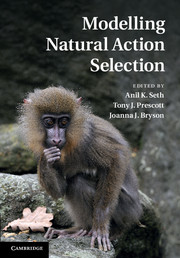Book contents
- Frontmatter
- Contents
- Foreword
- Preface
- Contributors
- 1 General introduction
- Part I Rational and optimal decision making
- Part II Computational neuroscience models
- 9 Introduction to Part II: computational neuroscience models
- 10 Action selection and refinement in subcortical loops through basal ganglia and cerebellum
- 11 Cortical mechanisms of action selection: the affordance competition hypothesis
- 12 Toward an executive without a homunculus: computational models of the prefrontal cortex/basal ganglia system
- 13 Hierarchically organised behaviour and its neural foundations: a reinforcement-learning perspective
- 14 The medial reticular formation: a brainstem substrate for simple action selection?
- 15 Understanding decision-making deficits in neurological conditions: insights from models of natural action selection
- 16 Biologically constrained action selection improves cognitive control in a model of the Stroop task
- 17 Mechanisms of choice in the primate brain: a quick look at positive feedback
- Part III Action selection in social contexts
- Index
- Plate section
- References
12 - Toward an executive without a homunculus: computational models of the prefrontal cortex/basal ganglia system
from Part II - Computational neuroscience models
Published online by Cambridge University Press: 05 November 2011
- Frontmatter
- Contents
- Foreword
- Preface
- Contributors
- 1 General introduction
- Part I Rational and optimal decision making
- Part II Computational neuroscience models
- 9 Introduction to Part II: computational neuroscience models
- 10 Action selection and refinement in subcortical loops through basal ganglia and cerebellum
- 11 Cortical mechanisms of action selection: the affordance competition hypothesis
- 12 Toward an executive without a homunculus: computational models of the prefrontal cortex/basal ganglia system
- 13 Hierarchically organised behaviour and its neural foundations: a reinforcement-learning perspective
- 14 The medial reticular formation: a brainstem substrate for simple action selection?
- 15 Understanding decision-making deficits in neurological conditions: insights from models of natural action selection
- 16 Biologically constrained action selection improves cognitive control in a model of the Stroop task
- 17 Mechanisms of choice in the primate brain: a quick look at positive feedback
- Part III Action selection in social contexts
- Index
- Plate section
- References
Summary
Summary
The prefrontal cortex (PFC) has long been thought to serve as an ‘executive’ that controls the selection of actions, and cognitive functions more generally. However, the mechanistic basis of this executive function has not been clearly specified, often amounting to a homunculus. This chapter reviews recent attempts to deconstruct this homunculus by elucidating the precise computational and neural mechanisms underlying the executive functions of the PFC. The overall approach builds upon existing mechanistic models of the basal ganglia (BG) and frontal systems known to play a critical role in motor control and action selection, where the BG provide a ‘Go’ versus ‘NoGo’ modulation of frontal action representations. In our model, the BG modulate working memory representations in prefrontal areas to support more abstract executive functions. We have developed a computational model of this system that is capable of developing human-like performance on working memory and executive control tasks through trial-and-error learning. This learning is based on reinforcement learning mechanisms associated with the midbrain dopaminergic system and its activation via the BG and amygdala. Finally, we briefly describe various empirical tests of this framework.
Introduction
There is widespread agreement that some regions of the brain play a larger role in controlling our overall behaviour than others, with a strong consensus that the prefrontal cortex (PFC) is a ‘central executive’ (e.g., Baddeley, 1986; Christoff et al., 2009; Conway et al., 2005; Duncan, 2001; Koechlin and Summerfield, 2007; Miller and Cohen, 2001; Shallice, 1988). However, this central executive label raises many more questions than it answers. How does the PFC know what actions or plans to select? How does experience influence the PFC? How do the specific neural properties of the PFC enable this kind of function, and how do these differ from those in other, non-executive areas? Without answers to these kinds of questions, the notion of a central executive is tantamount to positing a homunculus (small man) living inside the PFC and controlling our actions.
Information
- Type
- Chapter
- Information
- Modelling Natural Action Selection , pp. 239 - 263Publisher: Cambridge University PressPrint publication year: 2011
